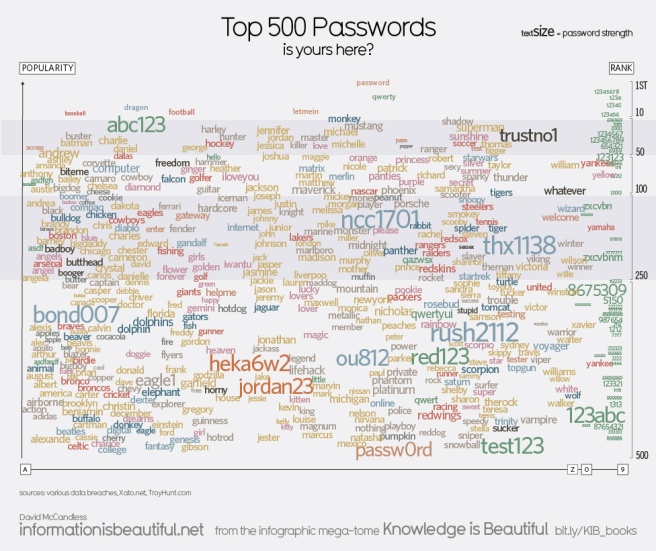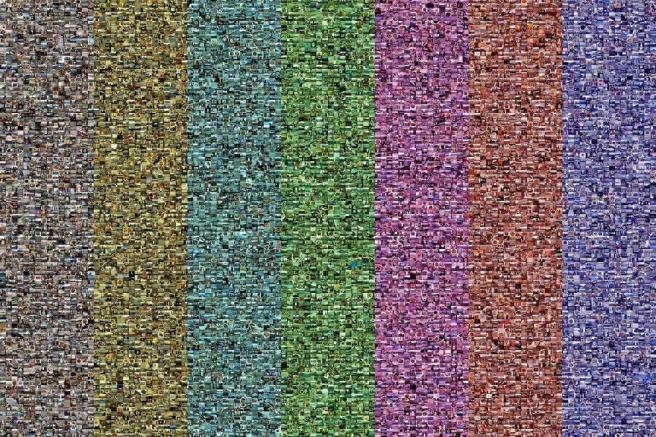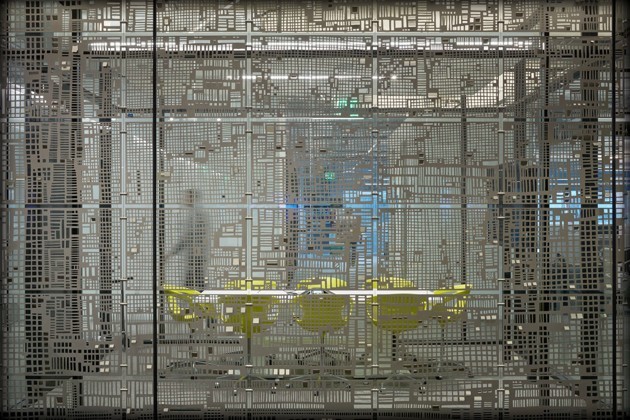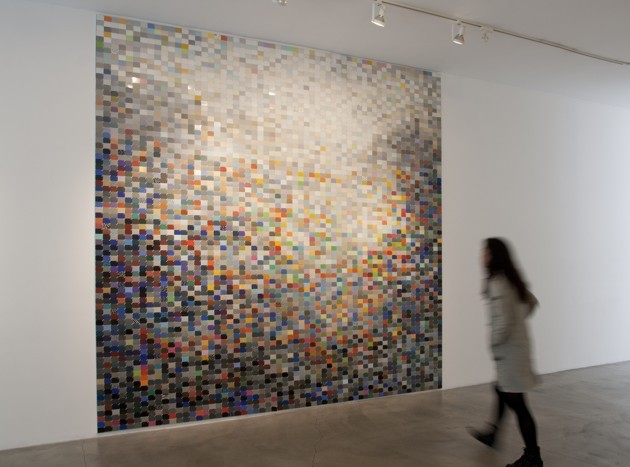“Glitch art is the practice of using digital or analog errors for aesthetic purposes by either corrupting digital data or physically manipulating electronic devices.”
Artist Research: Rosa Menkman
Experimenting With Glitch Art
I was inspired by the idea of social media and the use of smartphones taking over the lives of those who use them and tried to visualise this by using a photo of myself and applying a glitch effect to destroy the realistic representation of a person. It would be interesting to further this and create a series of all different peoples portraits, developing my own glitch application and applying to the images to warp the realistic presentation of a person.
Image glitch tool found at:
https://snorpey.github.io/jpg-glitch/
Parallax Examples
Interactive Data Artworks
Week 1 Reading & Lecture Notes
Reading Notes:
Although works have been being reproduced for many years, the introduction of mass mechanical reproducibility has removed the original aura of the subject by having the replica so easy accessible, that the audience no longer feels the need to view the original subject and in turn feel the presence of the performance or piece of art. You certainly do lose the feel (the aura) of the object when only viewing a representation or replica as the aura is so heavily tied to the presence of the performer. The destination between author and public is about to lose its fundamental character.
The introduction of photography was where we saw multiple replications of works truly begin to interfere with art tradition. Working as a photographer for the past three years I do believe that something has to be seen as well as photographed in order to experience the full impact of the work and I find it saddening to read and think about the fact that in todays culture, art is so easily accessible that people no longer feel the need to view the original and experience the aura of the work. The photographs I take are often a means of documentation, capturing events and people in my life to remind me of not only a face or view but more importantly the story; the emotion, the personality and the experience that comes with it.
Walter, Benjamin. The Work of Art in the Age of Mechanical Reproduction; Based on His Book “Illuminations.” Edited by Hannah Arendt. Translated by Harry Zohn. New York: Schocken Books, 1969.
Lecture Notes:
1945 Vannevar Bush – As we may think and the memes
1950 – Alan Turing – Computing machinery and Intelligence (teacher believes he came up with the concept of a computer)
1954 Norbert Weiner – Men, Machines and the World About
1964 Marshall McLuhan – The Medium is the Message
1985 Donna Harraway – The Cyborg Manifesto
1991 Terry Winograd – Computing as Writing
Ada Lovelace – first programmer
Binery numbers – true true = true, true false = false, false false = true or false
1938 first electronic computer
1943 Colossus first valve based computer
1951 UNIVAC first commercially available mainframe computer
1972 Intel 8008
Artist Research – Nathalie Miebach & David McCandless
The key aim of these works that follow are to translate a wealth of information into an aesthetic form. Numerous curators, scholars and artists believe that by working with data we are not reducing the human experience to numbers but rather gaining a greater understanding and awareness of very complex issues occurring in society today.
A lot of the artists I have discussed have begun data collection works as a result of being made aware of the immense pool of data that is collected about themselves. As I am sure you are all aware 99% of human interaction with digital technology now generates a data point. This includes every text, every call, every social media status or like, every credit-card swipe and Uber ride traces and records an individuals movements continually.
The Economist has described the smartphone as a ‘true personal computer, the defining innovation of the era, on par with the mechanical clock or the automobile in past centuries.’
“From Paint to Pixels,” The Atlantic, accessed 21 March, 2017, https://www.theatlantic.com/entertainment/archive/2015/05/the-rise-of-the-data-artist/392399/.
Nathalie Miebach
An artist who transforms weather patterns into complex sculptures and musical scores. Her artist statement found on her own website states;
|
|
| “Artist Statement,” Nathalie Miebach, accessed 21 March, 2017, http://nathaliemiebach.com/statement.html |
David McCandless
McCandless is an artist who has a great depth of knowledge regarding data, information & knowledge, creativity, design-thinking, data story-telling, the art & utility of data-visualisation. He speaks publicly, telling data-driven stories, using examples from across business, tech, science, communications, politics and culture. An example of his work is where he turned password data into simple and striking diagrams.

David McCandless, Top 500 Passwords, 2015, photograph.
David McCandless, Top 500 Passwords, 2015, Flickr, accessed 27 March, 2017, https://www.flickr.com/photos/25541021@N00/16677973354/.
Artist Research – Hasan Elahi
This artist began posting photos about every minute of everyday, sometimes hundreds of photos per day. This images included snapshots of receipts, unmade hotel beds, Starbucks cups, toilets he’s used, and every other seemingly pointless object he came in contact with throughout his day. Elahi would also through the use of his iPhone’s GPS, sync his live movements to a map which would then be displayed live on his website. Over the past few years, he’s gathered hundreds of thousands of images and therefore data points about his day to day life.
“It’s economics,” he said. Personal data conforms to supply-and-demand principles. So the best way to protect privacy is to give away as much as possible and “flood the market,” so that the government’s supply is worthless. People can also track themselves much more accurately than a third party. “You have data?” he asked, “Well I’ve got data too. By putting everything out there, the government’s data no longer means very much. I can tell them what I ate, where I slept, exactly what I was doing on every day over the last decade.”
“From Paint to Pixels,” The Atlantic, accessed 21 March, 2017, https://www.theatlantic.com/entertainment/archive/2015/05/the-rise-of-the-data-artist/392399/.
 Hasan Elahi, Thousand Little Brothers, 2014, composite image made of 32,000 images taken from the artist’s daily life.
Hasan Elahi, Thousand Little Brothers, 2014, composite image made of 32,000 images taken from the artist’s daily life.
Hasan Elahi, Thousand Little Brothers, 2014, SETUP, accessed 22 March, 2017, https://www.setup.nl/magazine/2015/01/de-kunstenaar-coveillance.
Artist Research – Laurie Frick
Laurie Frick is an artist that utilises various self-tracking data processes to construct different sculptures and large-scale installations. She believes that while numbers are abstract and unapproachable, human beings respond intuitively and emotionally to patterns.
Floating Data is a work that stands as a representation of her walking patterns. It is approximately two stories in height and made from 60 anodized aluminum panels. Frick utilised her own data and records, tracking her steps on her Fitbit and then combining it with her iPhone’s GPS data and location data from an online program called OpenPaths.
“I drew a little track that tries to capture the experience of walking speed, and the feel of walking through a busy neighbourhood near my apartment in Brooklyn”
Frick explained.

Laurie Frick, Floating Data, Walking Patterns, 2014.
In one of her popular series called Moodjam, she gathered thousands of samples of Italian laminate countertop styles from a recycling centre and then used them to develop a series of large scale murals and canvases that represented her recorded temperament over a number of weeks. She tracked and recorded her emotions, using an online program called Moodjam. This program allowed the user to select a colour that they feel correctly correlates with their mood. She created smaller artworks that represented a days ups and downs and larger ones which spanned over a number of weeks even months.
Frick is passionate about creating works that are more than just gathered information but rather a work that
‘serves as a metaphor for human experience, and thus belongs firmly in the art world.’

Laurie Frick, Moodjam 1, 2012, Abet Laminati italian countertop samples on alumalite panels.
“I say, run toward the data, take your data back and turn it into something meaningful.”
Frick said.
“From Paint to Pixels,” The Atlantic, accessed 21 March, 2017, https://www.theatlantic.com/entertainment/archive/2015/05/the-rise-of-the-data-artist/392399/.
Frick stated in a report that;
“Humans are incredibly noisy data objects”
and that;
“The data collected about us will unfold a personal narrative and story to reveal a hidden part of us we are trained to ignore…”
https://www.ncbi.nlm.nih.gov/pmc/articles/PMC3989686/#!po=22.7273
Idea Development – Concept Two
Another thought for assessment is the possibility of using the code from a work of my husbands and turning it into a work of art. He works as a software engineer and as an artist I always struggled to see the beauty in the code. I think it would be interesting to make something of his code that I find beautiful and aesthetically pleasing, unifying both of our talents to create something we both love. In other terms creating a statement piece about our relationship and the intricate strings that form our connection.





